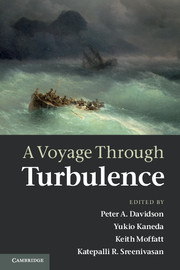Book contents
- Frontmatter
- Contents
- List of contributors
- Preface
- 1 Osborne Reynolds: a turbulent life
- 2 Prandtl and the Göttingen school
- 3 Theodore von Kármán
- 4 G.I. Taylor: the inspiration behind the Cambridge school
- 5 Lewis Fry Richardson
- 6 The Russian school
- 7 Stanley Corrsin
- 8 George Batchelor: the post-war renaissance of research in turbulence
- 9 A.A. Townsend
- 10 Robert H. Kraichnan
- 11 Satish Dhawan
- 12 Philip G. Saffman
- 13 Epilogue: a turbulence timeline
- References
1 - Osborne Reynolds: a turbulent life
Published online by Cambridge University Press: 07 October 2011
- Frontmatter
- Contents
- List of contributors
- Preface
- 1 Osborne Reynolds: a turbulent life
- 2 Prandtl and the Göttingen school
- 3 Theodore von Kármán
- 4 G.I. Taylor: the inspiration behind the Cambridge school
- 5 Lewis Fry Richardson
- 6 The Russian school
- 7 Stanley Corrsin
- 8 George Batchelor: the post-war renaissance of research in turbulence
- 9 A.A. Townsend
- 10 Robert H. Kraichnan
- 11 Satish Dhawan
- 12 Philip G. Saffman
- 13 Epilogue: a turbulence timeline
- References
Summary
Introduction
Scope
Articles on Osborne Reynolds' academic life and published works have appeared in a number of publications beginning with a remarkably perceptive anonymous obituary notice published in Nature within eight days of his death (on 21 February 1912) and a more extensive account written by Horace Lamb, FRS, and published by the Royal Society (Lamb, 1913) about a year later. More recent reviews have been provided by Gibson (1946), a student of Reynolds and later an academic colleague, by Allen (1970), who provided the opening article in a volume marking the passage of 100 years from Reynolds taking up his chair appointment at Manchester in 1868, and by Jackson (1995), in an issue of Proc. Roy. Soc. celebrating the centenary of the publication of Reynolds' 1895 paper on what we now call the Reynolds decomposition of the Navier–Stokes equations, about which more will be said later in the present chapter. A significant portion of the present account is therefore devoted to Reynolds' family and background and to hitherto unreported aspects of his character to enable his contributions as a scientist and engineer to be viewed in the context of his life as a whole. While inevitably some of what is presented here on his academic work will be known to those who have read the articles cited above, archive material held by the University of Manchester and The Royal Society and other material brought to light in the writers' personal enquiries provide new perspectives on parts of his career.
- Type
- Chapter
- Information
- A Voyage Through Turbulence , pp. 1 - 39Publisher: Cambridge University PressPrint publication year: 2011
References
- 6
- Cited by

